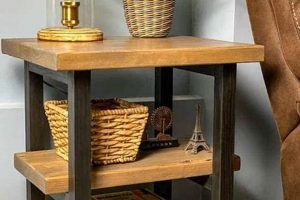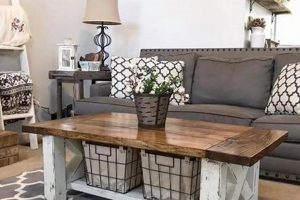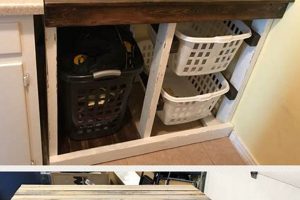A do-it-yourself gaming surface construction focuses on creating a customized platform specifically for tabletop games. It involves individuals undertaking the design and building of a table suited to their specific needs and preferences, rather than purchasing a pre-made option. For example, a person might construct a table with a recessed playing area, cup holders, and integrated storage for game components.
This approach offers several advantages, including cost savings, personalization, and the satisfaction derived from creating a functional object. It provides the opportunity to optimize the playing experience with features tailored to particular games or group sizes. Historically, creating bespoke furniture was common before mass production, and this approach harkens back to that tradition, blending functionality with individual expression.
The subsequent discussion will explore various design considerations, material choices, and construction techniques relevant to embarking on such a project. This includes an overview of common features, step-by-step building processes, and tips for achieving a durable and aesthetically pleasing final product.
Essential Construction Guidelines
The following recommendations provide insight into the successful design and creation of a custom gaming surface. These guidelines address key elements in the process to ensure a functional and aesthetically pleasing outcome.
Tip 1: Precise Measurement and Planning: Accurate dimensions of the intended playing area are crucial. Consider the size requirements of frequently played games and available space within the room. Develop a detailed schematic to ensure accurate material calculations and structural integrity.
Tip 2: Material Selection Considerations: Choose materials appropriate for both the tabletop surface and the supporting frame. Hardwoods such as maple or oak offer durability for the playing surface, while sturdy softwoods can be used for the frame. Consider moisture resistance and the potential for warping in humid environments.
Tip 3: Secure Frame Construction: Employ robust joinery techniques when assembling the frame, such as mortise and tenon, or reinforced screws with wood glue. A solid frame is essential to support the weight of the tabletop and prevent instability during use.
Tip 4: Smooth and Durable Surface Finishing: Proper sanding techniques are crucial for achieving a smooth playing surface. Apply multiple coats of a durable sealant or varnish to protect the wood from scratches and spills. Consider a matte finish to reduce glare and improve visibility.
Tip 5: Incorporate Recessed Playing Area: A recessed playing area helps contain game components and prevent them from sliding off the table. This can be achieved by constructing a frame within the larger tabletop surface and lining it with felt or other suitable material.
Tip 6: Implement Integrated Storage Solutions: Design storage compartments beneath the playing surface to house game boards, cards, and other accessories. Hinged access panels or pull-out drawers can provide convenient access to these items while maintaining a clean and organized appearance.
Tip 7: Add Functional Accessories: Consider incorporating cup holders to prevent spills, or LED lighting to improve visibility. These additions enhance the gaming experience and add a touch of personalization to the design.
Adherence to these recommendations contributes significantly to the construction of a durable, functional, and aesthetically pleasing gaming surface, maximizing its utility and enjoyment for years to come.
With these principles established, the article will now move to practical build scenarios and further design adaptations.
1. Dimension Accuracy
Dimension accuracy is a foundational element in the successful construction of a gaming surface. Inadequate precision in measurements directly impacts the functionality and structural integrity of the finished piece. An undersized playing surface may restrict gameplay, while an oversized one may prove unwieldy or unsuitable for the designated space. Errors in dimensioning can result in misaligned components, leading to an unstable or aesthetically displeasing final product. For example, a tabletop that is not precisely square can cause gameplay imbalances and visual disharmony.
The cascading effects of inaccurate dimensions extend beyond the playing surface itself. Mismatched frame components, resulting from imprecise cuts, can compromise the overall structural integrity, potentially leading to sagging or eventual collapse under sustained use. Moreover, inaccuracies compound during the assembly process, creating gaps or overlaps that necessitate additional remedial work. Consider a scenario where the internal frame is constructed using inaccurate measurements; this would impact the ability to integrate recessed play areas or storage compartments efficiently.
In conclusion, meticulous attention to dimension accuracy represents a fundamental prerequisite for a successful project. Precise measurements, coupled with diligent execution during the cutting and assembly stages, are essential for achieving a functional, stable, and aesthetically pleasing final product. Overlooking this aspect can result in significant complications, negating the cost-effectiveness and personalization benefits associated with a custom build.
2. Material Durability
Material durability is a paramount consideration in crafting a gaming surface. The longevity and functionality of the finished piece depend directly on the materials chosen. Substandard materials are susceptible to wear and tear, compromising both the aesthetic appeal and structural integrity. For example, a tabletop constructed from low-density fiberboard may exhibit warping or surface damage from spills, rendering it unsuitable for prolonged use. Conversely, hardwoods such as oak or maple, while more expensive, offer significantly enhanced resistance to scratching, denting, and moisture absorption.
The selection of durable materials extends beyond the tabletop surface to encompass the supporting frame. A frame constructed from inadequately treated softwood is prone to insect infestation or rot, particularly in environments with fluctuating humidity levels. This can lead to structural instability and eventual collapse, rendering the entire assembly unusable. Employing pressure-treated lumber or kiln-dried hardwoods for the frame significantly mitigates these risks, ensuring the long-term stability and integrity of the finished product. Moreover, the choice of fasteners and adhesives plays a crucial role in the overall durability. Inferior screws or glues can weaken over time, leading to joint failure and structural instability. Utilizing high-quality hardware and adhesives specifically designed for woodworking applications is essential for achieving a robust and long-lasting construction.
In conclusion, material durability is a non-negotiable factor in gaming surface construction. The initial investment in high-quality materials translates directly into a longer lifespan, reduced maintenance costs, and an enhanced playing experience. Neglecting this aspect can result in a product that deteriorates rapidly, negating the cost savings and personalization benefits associated with a custom build. Therefore, a comprehensive understanding of material properties and their suitability for this application is vital for a successful project.
3. Structural Integrity
Structural integrity, in the context of a self-assembled gaming surface, denotes the capacity of the table to withstand anticipated loads and stresses without deformation or failure. This aspect directly influences the functionality, safety, and longevity of the unit. A poorly constructed frame or tabletop is prone to collapse under the weight of game components, beverages, or even the casual pressure exerted during gameplay. The absence of robust structural design negates the benefits of cost savings and customization associated with a do-it-yourself approach, as the resulting product is inherently unstable and unreliable. For example, a frame utilizing insufficient bracing or improperly joined members is susceptible to racking, causing the tabletop to warp or detach from the frame.
Effective structural design necessitates careful consideration of material properties, joinery techniques, and load distribution. Selecting appropriate materials, such as hardwoods for high-stress areas and adequately sized frame members, contributes significantly to overall stability. Employing robust joinery methods, such as mortise and tenon joints or reinforced screw connections with wood glue, ensures secure and lasting connections between components. Distributing weight evenly across the frame through strategic placement of support members minimizes stress concentrations and reduces the risk of localized failure. The absence of these considerations frequently results in sagging tabletops, wobbly legs, and premature degradation of the structure.
In summary, structural integrity represents a critical design element in the construction of a gaming surface. Neglecting this aspect compromises the functionality, safety, and longevity of the unit. A thorough understanding of material properties, joinery techniques, and load distribution principles is essential for achieving a robust and reliable gaming surface that can withstand the rigors of frequent use. Over-engineering the structure within reasonable material and cost constraints is often preferable to underestimating the necessary strength and stability, preventing potential catastrophic failures and ensuring a safe and enjoyable gaming experience.
4. Surface Smoothness
Surface smoothness is a critical attribute of any gaming surface, directly influencing gameplay dynamics and user satisfaction. In the context of self-constructed tables, achieving an optimal level of smoothness requires careful material selection, meticulous preparation, and appropriate finishing techniques.
- Friction Reduction
A smooth surface minimizes friction, facilitating the effortless movement of game pieces across the tabletop. This is particularly crucial for games involving dice rolling, card sliding, or strategic piece placement. Reduced friction enhances the tactile experience and prevents unintended disruptions to gameplay. For example, a rough or uneven surface can cause dice to tumble erratically or cards to catch, detracting from the overall gaming experience.
- Damage Prevention
A smooth, properly finished surface protects game components from abrasion and damage. Rough surfaces can scratch or scuff game pieces, cards, and miniatures, reducing their aesthetic appeal and potentially impacting their functionality. A smooth surface acts as a protective barrier, preventing direct contact between delicate game components and the underlying substrate. This is especially important for collectible or irreplaceable game pieces.
- Aesthetic Enhancement
Surface smoothness contributes significantly to the aesthetic appeal of the finished gaming surface. A smooth, well-polished surface reflects light evenly, creating a visually appealing and professional-looking tabletop. Conversely, a rough or uneven surface can appear unfinished and detract from the overall aesthetic quality. The choice of finish, such as a matte or gloss varnish, further influences the visual characteristics of the surface.
- Ease of Cleaning
A smooth surface is easier to clean and maintain than a rough or textured one. Spills, dust, and other debris can be easily wiped away from a smooth surface, preventing staining or damage. A rough surface, on the other hand, can trap dirt and liquids, requiring more intensive cleaning methods. The use of a sealant or varnish further enhances the cleanability and stain resistance of the surface.
The foregoing facets underscore the significance of surface smoothness in the construction of a gaming surface. Optimizing this attribute through careful material selection, preparation, and finishing techniques enhances the functionality, aesthetic appeal, and longevity of the finished product, ultimately contributing to a more enjoyable gaming experience.
5. Feature Integration
Feature integration, in the context of a self-constructed gaming surface, represents the incorporation of supplementary elements designed to enhance functionality and user experience. This aspect differentiates a basic tabletop from a specialized gaming platform tailored to specific needs and preferences. Thoughtful integration maximizes usability and elevates the overall gaming experience. The subsequent discussion explores several key facets of feature integration within the realm of creating personalized gaming surfaces.
- Recessed Playing Area
A recessed playing area provides a designated space for game components, preventing them from sliding off the table during gameplay. This feature is particularly useful for games involving numerous pieces, cards, or dice. The recessed area can be customized to specific dimensions and lined with felt or other materials to protect game components and reduce noise. The depth of the recess can be adjusted to accommodate different game types and preferences. For example, a deeper recess may be preferred for miniature wargaming to prevent accidental displacement of figures.
- Integrated Storage Compartments
Storage compartments integrated into the table design offer a convenient solution for storing game components when not in use. These compartments can be strategically located beneath the playing surface, within the frame, or along the perimeter of the table. Hinged access panels, pull-out drawers, or hidden compartments can be used to conceal the storage areas while maintaining a clean and organized appearance. The size and configuration of the compartments can be customized to accommodate specific game collections or accessory storage needs. A dedicated compartment for card storage, for example, prevents warping and damage to valuable card decks.
- Cup Holders and Accessory Mounts
The incorporation of cup holders and accessory mounts prevents spills and provides convenient locations for holding drinks, snacks, and other gaming accessories. Cup holders can be integrated into the tabletop surface or attached to the frame. Accessory mounts can be used to attach lighting fixtures, scoreboards, or electronic devices to the table. Proper placement of these features minimizes disruption to gameplay and enhances the overall gaming environment. For instance, adjustable LED lighting can provide optimal illumination for miniature painting or card reading without casting harsh shadows.
- Integrated Power and Connectivity
The integration of power outlets and connectivity ports allows for the convenient use of electronic devices during gameplay. This feature is particularly useful for games that require electronic components, such as timers, score trackers, or digital rulebooks. Power outlets can be discreetly integrated into the tabletop surface or concealed within the frame. Connectivity ports, such as USB ports or Ethernet ports, allow for seamless connection to external devices. This integration facilitates the use of online gaming resources and enhances the interactive gaming experience.
The foregoing facets of feature integration demonstrate the potential for enhancing the functionality and enjoyment of a self-constructed gaming surface. Thoughtful consideration of these elements allows for the creation of a customized gaming platform tailored to individual needs and preferences, ultimately enriching the overall gaming experience and maximizing the utility of the constructed space.
6. Aesthetic Appeal
Aesthetic appeal holds considerable significance in the construction of a customized gaming surface. Beyond its functional purpose, the visual presentation of the finished piece contributes substantially to the overall gaming experience and its integration within the surrounding environment. The design choices made during the construction process, including material selection, finishing techniques, and decorative elements, collectively influence the aesthetic value of the finished product.
- Material Palette and Texture
The selection of materials exerts a primary influence on the aesthetic character of the constructed surface. Different wood species, for instance, exhibit distinct grain patterns, colors, and textures. Cherry provides a warm, reddish hue and a fine grain, while oak presents a more pronounced grain and a lighter tone. The combination of different materials, such as wood and metal, can introduce visual contrast and enhance the design’s aesthetic complexity. Furthermore, the texture of the surface, whether smooth or subtly textured, affects the tactile experience and visual impression. A highly polished surface reflects light and conveys a sense of refinement, while a textured surface can introduce a more rustic or informal aesthetic.
- Finishing Techniques and Coloration
The application of finishing techniques, such as staining, varnishing, or painting, profoundly impacts the visual appearance of the wood surface. Staining can enhance the natural grain patterns and deepen the color of the wood. Varnishing provides a protective layer and imparts a sheen to the surface, ranging from matte to high gloss. Painting offers a wide range of color options and allows for the incorporation of custom designs or patterns. The choice of finishing technique should complement the material selection and intended aesthetic style. A dark stain and matte varnish, for example, can create a sophisticated and understated appearance, while a bright paint color can inject a sense of playfulness and vibrancy.
- Incorporation of Decorative Elements
The integration of decorative elements, such as inlays, carvings, or edge details, adds visual interest and personalization to the gaming surface. Inlays can be crafted from contrasting wood species, metal, or other materials to create intricate patterns or designs. Carvings can add three-dimensional texture and depth to the surface. Edge details, such as rounded edges or decorative moldings, enhance the visual appeal and improve the comfort of use. These elements can be customized to reflect individual preferences or to complement the theme of the games played on the surface. For instance, a gaming surface designed for fantasy role-playing games might incorporate Celtic knotwork or dragon motifs.
- Integration with Surrounding Environment
The aesthetic appeal of the constructed surface is further enhanced by its integration with the surrounding environment. The design should complement the existing decor and architectural style of the room. The color palette, material choices, and overall design should harmonize with the surrounding furniture, lighting, and wall colors. A gaming surface that clashes with its surroundings can detract from the overall aesthetic quality of the space. Careful consideration of the room’s dimensions and layout ensures that the surface is appropriately sized and positioned within the environment, optimizing both its functionality and visual impact.
These facets demonstrate that achieving aesthetic appeal in a crafted gaming surface involves deliberate attention to material properties, finishing applications, embellishment options, and spatial harmony. When each aspect is carefully considered, the table becomes more than a functional item, instead transforming into a showpiece.
7. Accessibility
Accessibility, in the context of a gaming surface, pertains to the ease with which individuals, regardless of physical abilities or limitations, can effectively utilize the playing area and its associated features. The importance of accessibility as a component of gaming surface design is underscored by the fundamental principle of inclusivity, ensuring that all interested parties can participate in tabletop gaming activities. A table designed without accessibility considerations may inadvertently exclude individuals with mobility impairments, visual limitations, or other physical challenges, thereby limiting their opportunities for social interaction and recreational engagement. For example, a table with insufficient legroom beneath the playing surface restricts access for wheelchair users, while a tabletop with excessive height poses challenges for individuals with limited reach.
Practical applications of accessibility-focused design principles involve incorporating adjustable height mechanisms to accommodate individuals of varying statures and those using mobility aids. Providing ample legroom beneath the playing surface, typically exceeding 27 inches in height, allows for comfortable wheelchair maneuverability. Implementing contrasting color schemes and tactile markers on game components and the playing surface improves visibility and tactile identification for individuals with visual impairments. Strategically positioning cup holders and accessory mounts within easy reach further enhances usability for all participants. Furthermore, integrating voice-activated or touch-sensitive controls for electronic components, such as lighting or score trackers, promotes accessibility for individuals with motor skill impairments. The design of the table, if executed correctly, will give the gaming experience to a wider variety of people.
Effective integration of accessibility features into gaming surface design necessitates a thorough understanding of universal design principles and the specific needs of diverse user groups. While incorporating these features may present initial design challenges and potentially increase construction costs, the benefits of inclusivity and expanded participation far outweigh the perceived drawbacks. By prioritizing accessibility, designers and builders can create gaming surfaces that foster social interaction, promote inclusivity, and enhance the overall gaming experience for all participants, and provide a template for others to follow. It moves the space beyond personal use to something that can enrich a community.
Frequently Asked Questions
The subsequent section addresses common inquiries concerning the design, construction, and functionality of personalized gaming surfaces. The responses provided offer guidance based on established practices and technical considerations.
Question 1: What is the optimal height for a tabletop gaming surface?
The recommended height generally falls between 28 and 30 inches. This range accommodates a comfortable playing posture for most adults while seated. However, individual preferences and chair heights should be considered.
Question 2: What materials are most suitable for the tabletop playing surface?
Hardwoods such as maple, oak, or birch offer durability and resistance to wear. Medium-density fiberboard (MDF) provides a smooth, stable surface but requires a protective finish to prevent moisture damage.
Question 3: How can a recessed playing area be effectively integrated into the design?
A frame constructed from dimensional lumber can be attached to the underside of the tabletop to create the recess. The depth of the recess should be determined based on the height of the game components intended for use.
Question 4: What techniques can be employed to minimize glare on the tabletop surface?
Applying a matte finish varnish or sealant reduces light reflection. Diffused lighting sources positioned above the table can also minimize glare and improve visibility.
Question 5: How can stability be ensured, particularly for larger gaming surfaces?
Reinforcing the frame with cross braces and utilizing sturdy legs are essential. Metal legs or a central support structure can provide additional stability for larger tables.
Question 6: What considerations should be made for accommodating wheelchair users?
Ensure adequate legroom beneath the table, typically a minimum of 27 inches in height. Avoid obstructive features, such as aprons or support structures, that impede wheelchair maneuverability.
In summary, careful planning, appropriate material selection, and attention to structural integrity are crucial for a functional and aesthetically pleasing gaming surface. These considerations promote longevity and user satisfaction.
The discussion will now proceed to explore various design modifications and customization options for individual projects.
diy board game table
The preceding exploration of the diy board game table has illuminated the multifaceted considerations inherent in its design and construction. From ensuring structural integrity and material durability to optimizing surface smoothness and feature integration, a comprehensive understanding of these elements is crucial. Emphasis has been placed on accessibility and aesthetic appeal as integral components that enhance the overall gaming experience and inclusivity.
The insights presented herein should serve as a practical foundation for individuals embarking on such projects. Implementing these principles will contribute to the creation of functional, durable, and aesthetically pleasing gaming surfaces that meet specific needs and preferences. Continued exploration of innovative design approaches and material technologies will undoubtedly further refine the possibilities within this domain, promoting enhanced gameplay and personalized recreational spaces.







